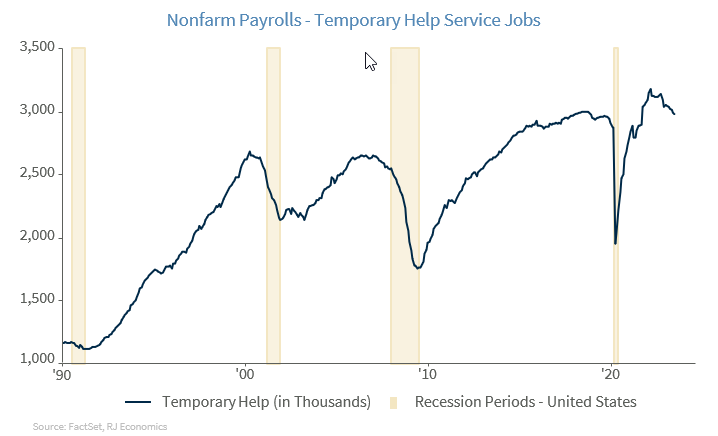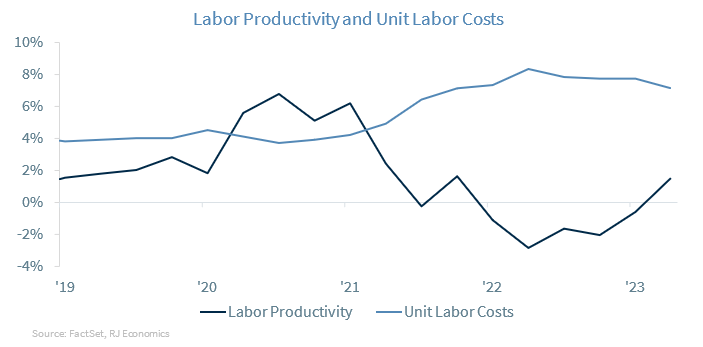July employment comes in weaker than expected
Chief Economist Eugenio J. Alemán discusses current economic conditions.
Nonfarm employment numbers seem to be following the same script as the disinflationary process for the Federal Reserve (Fed), that is, they are both slowing, but not enough for the Fed to stop worrying about hitting its 2.0% inflation target going forward and, not enough to end this rate hike cycle. For now, and according to the June Summary of Economic Projections (SEP) ‘dot-plot,’ the Fed still has one more 25 basis point increase for the federal funds rate before the end of this year.
However, this could change after the September Federal Open Market Committee (FOMC) meeting, which is scheduled to take place on September 19-20 as the FOMC is also scheduled to publish a new SEP and there will be an updated ‘dot plot’.
We pointed out, after the nonfarm payroll in June, that there were several indicators in that report that were, potentially, signaling weakness in the jobs market going forward. One of these indicators was the temporary help services jobs sector. That sector shed 20,200 jobs in June and another 22,100 jobs in July. The graph below shows what typically happens to temporary help services jobs before recessions even though 1991 and 2003 were atypical periods. However, the sector tends to signal some weakness in the labor market and this time around it seems that the signal continues to point to weakness ahead.
However, the decline in the rate of unemployment, from 3.6% in June to 3.5% in July, will continue to keep Fed officials on edge regarding the potential threat for a wage-price spiral that could keep inflation higher than the 2.0% Fed target.
Interestingly enough, even the commentary by Fed Chair Jerome Powell that the Fed staff no longer has a recession in its forecast was a funny commentary to us, as it could be argued that not even Fed economists believe in the power of monetary policy to weaken economic activity. Of course, markets took the commentary as an indication of a higher probability for a soft landing, but it could well be interpreted as an inability to slow down economic activity even with current interest rates.
That is, if Fed officials believe that current interest rates will not be able slow down the economy and it continues to fear the potential consequences from a still tight labor market on the disinflationary process, then it may be willing to go even higher in terms of interest rates. Having said this, recent increases in the yield on the 10-year Treasury due to the recent decision by Fitch to downgrade the risks rating of the U.S., if sustained over time, could also convince Fed officials that they don’t need to go higher in terms of the federal fund rate.1 We will have to wait until the release of the SEP and the ‘dot-plot’ after the FOMC meeting and confirm Fed officials view on the future path of rates.
Good productivity number should help the Fed
U.S. nonfarm business productivity was higher than expected during the second quarter of 2023, up 3.7%. This pushed unit labor costs up by only 1.6% during the quarter in what was very good news for those analysts who believe that inflation will remain higher going forward because of increases in worker wages and salaries. It was also good news for Fed policymakers, who have remained concerned that wage pressures could continue to contribute to keeping inflation higher than the institution’s target rate of 2.0% over the longer term.
However, the news on productivity and unit labor costs is good news for inflation going forward and another indication that even if the economy continues to grow ahead of potential output, i.e., 1.8% per year, inflation will continue to slow down to pre-pandemic levels, which is a far cry from what many have been prognosticating since the COVID-19 recession.
We believe that fears that so-called ‘structural’ changes in the economy will prevent the Fed from achieving its inflation target have been overblown. It is true that productivity numbers are very volatile, and the Fed may not be ready to call its fight against inflation over after the release of this number, but it adds to evidence that inflation, while still not low enough, continues to move in the desired direction.
Economic and market conditions are subject to change.
Opinions are those of Investment Strategy and not necessarily those of Raymond James and are subject to change without notice. The information has been obtained from sources considered to be reliable, but we do not guarantee that the foregoing material is accurate or complete. There is no assurance any of the trends mentioned will continue or forecasts will occur. Last performance may not be indicative of future results.
Consumer Price Index is a measure of inflation compiled by the US Bureau of Labor Statistics. Currencies investing is generally considered speculative because of the significant potential for investment loss. Their markets are likely to be volatile and there may be sharp price fluctuations even during periods when prices overall are rising.
Consumer Sentiment is a consumer confidence index published monthly by the University of Michigan. The index is normalized to have a value of 100 in the first quarter of 1966. Each month at least 500 telephone interviews are conducted of a contiguous United States sample.
Personal Consumption Expenditures Price Index (PCE): The PCE is a measure of the prices that people living in the United States, or those buying on their behalf, pay for goods and services. The change in the PCE price index is known for capturing inflation (or deflation) across a wide range of consumer expenses and reflecting changes in consumer behavior.
The Consumer Confidence Index (CCI) is a survey, administered by The Conference Board, that measures how optimistic or pessimistic consumers are regarding their expected financial situation. A value above 100 signals a boost in the consumers’ confidence towards the future economic situation, as a consequence of which they are less prone to save, and more inclined to consume. The opposite applies to values under 100.
Certified Financial Planner Board of Standards Inc. owns the certification marks CFP®, CERTIFIED FINANCIAL PLANNER™, CFP® (with plaque design) and CFP® (with flame design) in the U.S., which it awards to individuals who successfully complete CFP Board's initial and ongoing certification requirements.
Links are being provided for information purposes only. Raymond James is not affiliated with and does not endorse, authorize or sponsor any of the listed websites or their respective sponsors. Raymond James is not responsible for the content of any website or the collection or use of information regarding any website's users and/or members.
GDP Price Index: A measure of inflation in the prices of goods and services produced in the United States. The gross domestic product price index includes the prices of U.S. goods and services exported to other countries. The prices that Americans pay for imports aren't part of this index.
The Conference Board Leading Economic Index: Intended to forecast future economic activity, it is calculated from the values of ten key variables.
The Conference Board Coincident Economic Index: An index published by the Conference Board that provides a broad-based measurement of current economic conditions.
The Conference Board lagging Economic Index: an index published monthly by the Conference Board, used to confirm and assess the direction of the economy's movements over recent months.
The U.S. Dollar Index is an index of the value of the United States dollar relative to a basket of foreign currencies, often referred to as a basket of U.S. trade partners' currencies. The Index goes up when the U.S. dollar gains "strength" when compared to other currencies.
The FHFA House Price Index (FHFA HPI®) is a comprehensive collection of public, freely available house price indexes that measure changes in single-family home values based on data from all 50 states and over 400 American cities that extend back to the mid-1970s.
Import Price Index: The import price index measure price changes in goods or services purchased from abroad by U.S. residents (imports) and sold to foreign buyers (exports). The indexes are updated once a month by the Bureau of Labor Statistics (BLS) International Price Program (IPP).
ISM New Orders Index: ISM New Order Index shows the number of new orders from customers of manufacturing firms reported by survey respondents compared to the previous month. ISM Employment Index: The ISM Manufacturing Employment Index is a component of the Manufacturing Purchasing Managers Index and reflects employment changes from industrial companies.
ISM Inventories Index: The ISM manufacturing index is a composite index that gives equal weighting to new orders, production, employment, supplier deliveries, and inventories.
ISM Production Index: The ISM manufacturing index or PMI measures the change in production levels across the U.S. economy from month to month.
ISM Services PMI Index: The Institute of Supply Management (ISM) Non-Manufacturing Purchasing Managers' Index (PMI) (also known as the ISM Services PMI) report on Business, a composite index is calculated as an indicator of the overall economic condition for the non-manufacturing sector.
Consumer Price Index (CPI) A consumer price index is a price index, the price of a weighted average market basket of consumer goods and services purchased by households. Changes in measured CPI track changes in prices over time.
Producer Price Index: A producer price index (PPI) is a price index that measures the average changes in prices received by domestic producers for their output.
Industrial production: Industrial production is a measure of output of the industrial sector of the economy. The industrial sector includes manufacturing, mining, and utilities. Although these sectors contribute only a small portion of gross domestic product, they are highly sensitive to interest rates and consumer demand.
The NAHB/Wells Fargo Housing Opportunity Index (HOI) for a given area is defined as the share of homes sold in that area that would have been affordable to a family earning the local median income, based on standard mortgage underwriting criteria.
The S&P CoreLogic Case-Shiller U.S. National Home Price NSA Index measures the change in the value of the U.S. residential housing market by tracking the purchase prices of single-family homes.
The S&P CoreLogic Case-Shiller 20-City Composite Home Price NSA Index seeks to measures the value of residential real estate in 20 major U.S. metropolitan.
Source: FactSet, data as of 7/7/2023


